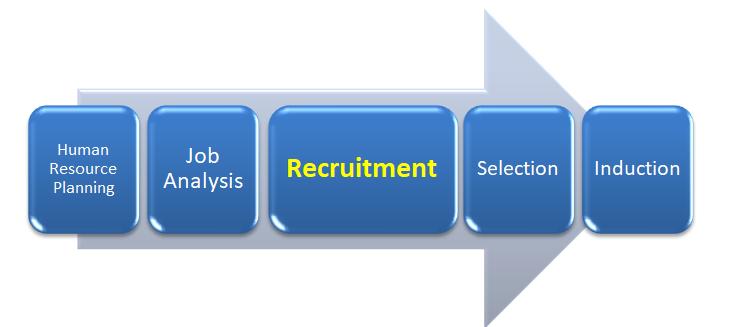- Staffing refers to the process of finding the right employee with appropriate qualifications or experience and recruiting them to fill a position, role, or job.
- Through this process, organizations acquire, deploy, and retain a workforce of sufficient quantity and quality to create positive impacts on the organization’s effectiveness.
- In management, staffing is an operation of recruiting the employees by evaluating their skills and knowledge before offering them specific job roles accordingly.
- Staffing is the function of employee recruitment, screening and selection performed within an organization or business to fill job openings. Other areas of employment which may be handled by a staffing department are orientation, training, retention and termination.
Importance of staffing
- Staffing helps to find and hire people who are qualified for the job position and will benefit the company.
- It also improves the quality and quantity of work done by the company because they have staffed the optimum people.
- Staffing an organization focuses on both the quantity and the quality of the staff.
- If an organization does not have the competent personnel, then it cannot perform the functions of management like planning, organizing and control functions properly.
- The management can ensure the right kinds of personnel by performing the staffing function.
- A huge amount is spent on recruitment, selection, training, and development of employees. To get the optimum output, the staffing function should be performed in an efficient manner.
Functions of Staffing
- The first and foremost function of staffing is to obtain qualified personnel for different jobs position in the organization.
- In staffing, the right person is recruited for the right jobs, therefore it leads to maximum productivity and higher performance.
- It helps in promoting the optimum utilization of human resource through various aspects.
- Job satisfaction and morale of the workers increases through the recruitment of the right person.
- Staffing helps to ensure better utilization of human resources.
- It ensures the continuity and growth of the organization, through development managers.
When staffing starts? Quantity and Quality consideration
The quantity is the number of staff. The organization forecasts workforce quantity requirements and then compares it to the available workforce. If the headcount matches the requirement, then the organization is fully staffed. If the requirement exceeds the number of available employees, then the organization is understaffed. If the available staff exceeds the requirements, then the organization is overstaffed and may need to stop hiring and lay off employees. When a company is understaffed, the staffing process may restart.
The quality is having the right person for the job. The right person should have a job and an organization match. The job match involves the employee’s knowledge, skills, abilities, and other characteristics and how they work with the job’s tasks. The organization match is when the person has the same organizational values as the organization.
Staffing Function includes following Activities
- Recruitment,
- Selection,
- Placement
- Training and development
- Wage and salary Administration
- Welfare
Recruitment
Herbert Heneman has described an effective recruiting process as the cornerstone of an effective staffing system.

- Recruitment is the process of searching for prospective employees and stimulating them to apply for the jobs in the organization.
- Recruitment is defined as, “the process of finding and attracting capable applicants for employment. The process begins when new recruits are sought and ends when their applications are submitted. The result is a pool of applicants from which new employees are selected.”
- According to Dale S. Beach, “Recruitment is the development and maintenance of adequate manpower resources. It involves the creation of a pool of available labour upon whom the organisation can draw when it needs additional employees.“
- Recruitment is a positive process because it increases the selection ratio by attracting a large number of applicants for the advertised jobs.
Purposes and Importance
- To provide a pool of potentially qualified job candidates.
- Increase the pool of job candidates at minimum cost.
- Help increase the success rate of the selection process by reducing the number of visibly under-qualified or overqualified job applicants.
- Determine the present and future requirements of the organisation in conjunction with its personnel planning and job-analysis activities.
- Begin identifying and preparing potential job applicants who will be appropriate candidates.
- Evaluate the effectiveness of various recruiting techniques and sources for all types of job applicants.
Sources of Recruitment
Two Source Of Recruitment:
- Internal Source
- External Source
Internal Sources:
Internal recruitment seeks applicants for positions from those who are currently employed.
Internal sources include
- Present employees,
Transfer and
Promotion
- Employee referrals,
- Former employees, and
- Former applicants.
External sources Recruitment
(1) Advertisements :
Advertisement in local or national newspapers and trade and professional journals is generally used when qualified or experienced personnel are not available from other sources. Advertisement gives the management a wider range of candidates from which to choose.
(2) Educational Institutions :
- Direct recruitment from educational institutions for jobs which require technical or professional qualifications has become a common practice.
- A close liaison between the company and educational institutions helps in getting suitable candidates to man various positions. This is also known as `Campus Recruitment’.
(3) Professional or Trade Associations :
- Many associations provide placement services for their members.
- These services may consist of compiling job seeker’s lists and providing access to members during regional or national conventions. Many associations publish or sponsor trade journals or magazines for their members. These publications often carry classified advertisements from employers interested in recruiting their members.
- Professional or trade associations are particularly useful for attracting highly educated, experienced or skilled personnel.
(4) Management Consultants :
- Management consultancy firms help the organisations to recruit technical, professional and managerial personnel.
- They specialize in middle-level and top-level executive placements. They maintain data bank of persons with different qualifications and skills and even advertise the jobs on behalf of their clients to recruit right type of personnel.
(5) Write-ins are those who send written enquiries. These job seekers are asked to complete application forms for further processing.
(6) Radio and Television : Radio and television are used generally by Government departments only. Radio and television can be used to reach certain types of job applicants such as skilled workers.
(7) Competitors : Rival firms can be a source of recruitment. This is called `poaching’. This method involves identifying the right people in rival companies, offering them better terms and luring them away.
Selection
Selection
- Selection is the process of picking individuals (out of the pool of job applicants) with requisite qualifications and competence to fill jobs in the organisation.
- Selection is the process of differentiating between applicants in order to identify and hire those with a greater likelihood of success in a job.
Selection Process
Preliminary Interview
- Preliminary interviews are also called screening interviews.
- It is used to eliminate those candidates who do not meet the minimum eligibility criteria laid down by the organization.
- The skills, academic and family background, competencies and interests of the candidate are examined during preliminary interview
Application blank
- The candidates who clear the preliminary interview are required to fill application blank.
- It contains data record of the candidates such as details about age, qualifications, reason for leaving previous job, experience, etc.
Selection Tests
- Job seekers who pass the screening and the preliminary interview are called for tests.
- Different types of tests may administered, depending on the job and the company.
- Various written tests conducted during selection procedure are
- aptitude test,
- intelligence test,
- reasoning test,
- personality test,
- interest test etc
Employment Interviews
- It is used to find whether the candidate is best suited for the required job or not.
- Interview is a formal, in-depth conversation conducted to evaluate the applicant’s acceptability
Interview can be adapted to unskilled, skilled, managerial and professional employees to evaluate the applicant’s acceptability
Reference and background check
- Many employers request names, addresses, and telephone numbers of references for the purpose of verifying information and, perhaps, gaining additional background information on an applicant
- Previous employers, known public figures, university professors, neighbours or friends can act as references.
Reference checks serve two important purposes.
- First purpose is to gain insight about the potential employee from the people who have had previous experience with him or her. This is a good practice considering the fact that between 20 to 25 per cent of job applicants there is at least one fraudster
- Second purpose for reference checks is to assess the potential success of a prospect
Selection decision
- The different stages in the selection process have been used to narrow the number of candidates.
- The final decision has to be made from the pool of individuals who pass the tests, interviews and reference checks.
Physical examination
- After the selection decision and before the job after offer is made, the candidate is required to undergo a physical fitness test.
- A job offer is, often, contingent upon the candidate being declared fit after the physical examination.
Job Offer and Appointment letter
- Job offer is made through a letter of appointment. Such a letter generally contains a date by which the appointee must report on duty.
Evaluation of Selection programme
- The broad test of the effectiveness of the selection process is the quality of the personnel hired
- A periodic audit of effectiveness of hired employee need to be done.
- Audit must be conducted by people who work independent of the HR department.

